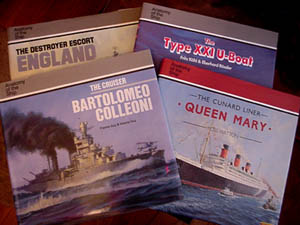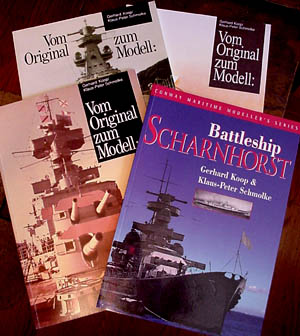Wether you have just ordered a fiberglass hull or model, or are looking at your new project, there are some important first steps before you begin working on it.
Building a ship model is a considerable effort in time and money, so it is worthwhile to do adequate research to make sure that your miniature is a fair representation of the prototype.
Gathering information
Luckily, there has been an explosion of warship information over the last 25 years. Plans, books and photos exist for many types of vessels, even relatively esoteric types. Of course, the more popular or well know the prototype, the easier your research task will be; the Missouri or Bismarck has a lot more information available than Danube river monitors. But, this is all part of the challenge.
The first thing you will need is a good set of plans. If you are just starting out, you are probably better off getting a set from a reliable source, instead of attempting to draw your own. In our Links section, you will find some suppliers for plans. Most kits and some hull makers include plans of varying degrees of completeness with their products - you should check with them to see what other material would be needed for the project.
The best plans are those from official sources, but be aware that even these will only represent a certain period of time. Ships, especially warships are dynamic structures, and are modified all the time. Significant variations will often be present within classes of ships - for example, the Fletcher class of US destroyers had many variants - round bridge, square bridge, even a few that had catapults to launch aircraft! Determining both which ship to model, and the timeframe you wish to represent is critical in the early stages of planning.
Plans drawn up by model makers will vary in quality and accuracy as you might expect. One important thing to note is that quality of draftsmanship does not equal quality of accuracy. I have seen some beautiful plans from Germany that were inaccurate, and rather crudely drawn sketches that were correct. ALWAYS check your sources, and cross check them against photos.
Again, we are very fortunate that reference books exist for many types of warships. Often labors of love, these represent countless hours of effort by the authors.
You are indeed fortunate if your prototype is covered by the Anatomy of the Ship series, as these are perhaps the ideal resource for modelers.

Another great series originated in Germany, the Vom Orignal sum Modell Series, which covers units of the German Navy, in both World War I and II.

Of course, many other books exist, depending on your interests. Some good publishers include:
Naval Institute Press - the premier publisher of naval history in the world, with many great titles
Schiffer Publications - translates a great many German language books, also original works in English
A subject dear to my heart, since I own SeaPhoto! Of course, my service is just one of many great ways to get photos of the subject you are modeling.
Taking your own...
If the vessel is still in service, you should be able to arrange a tour of her to photograph her. I know this is true of the vast majority of US subjects, and is likely to be so for many other Western nations. This is the best way to document a particular ship. The basics are
There are a few services that offer photos for the ship modeler. If you hear of more, please let me know.
SeaPhoto - my service, covering modern warships, and most of the museum warships in the US and Canada, as well as a couple in England.
The Floating Drydock - another great resource, has great views of World War II era ships, as well as some more modern subjects. They have a lot of shots taken at Mare Island during the war - some of the most useful views of US Warships that exist today. Vital for the US World War II modeler.
Navsource - great archive of photos for the US Navy.
US Navy Digital Images Archives - source for online imagery direct from the US Navy.
![]() Please email your suggestions to
me here. Thank you!
Please email your suggestions to
me here. Thank you!
Back to Construction Articles
58
Version 2.1 07/15